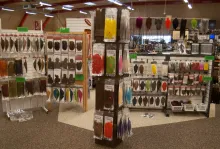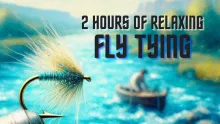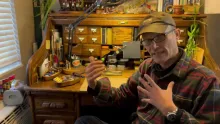I have to admit a particular fondness for woodduck flank. Ever since I was given my first baggie of feathers from a duck hunting friend, I was smitten. The color - the texture - the barring of the feathers.

Woodduck flank feathers are without a doubt one of the most beautiful feathers in all of nature. Their utility as a fly tying material is legendary - and deservedly so. They can be used in many different ways in a variety of fly styles. Certainly for trout fly tyers, woodduck flank feathers possess magic powers.
I have to admit a particular fondness for woodduck flank. Ever since I was given my first baggie of feathers from a duck hunting friend, I was smitten. The color - the texture - the barring of the feathers - like so many natural fly tying materials they have a natural beauty above and beyond the world of fly tying. The fact that they are so useful as a material for trout flies makes my modest stash of feathers one of my most prized possessions.
Indeed, you truly can never have too many woodduck feathers.
The terms woodduck, summer duck, and mandarin duck are oftentimes used interchangeably in fly tying texts, most often in the context of the buff colored barred flank feathers.
Summer duck is a nickname that has been used for both the mandarin duck and the woodduck, there are in fact two distinct birds behind all these feathers. The woodduck, Aix sponsa, is native to North America while the mandarin duck, Aix galericulata, is native to Asia. The two are closely related biologically, the hens being almost indistinguishable in appearance, but the drakes are quite distinct on the water. However, it is the flank feathers of the drakes that are of great interest to fly tyers. They are so nearly identical that one can easily be used as a substitute for the other in all but the most strict tying recipes.
Undoubtedly the most common and well known use for woodduck flank feathers is the wings of dry flies. In fact, the upright and split woodduck flank wings on such flies as the Quill Gordon and the Hendrickson is the hallmark of Catskill style dry flies. It's not the only use for these precious feathers, however. Woodduck flank feathers are used in flies ranging from tiny emerging midge imitations to large trolling smelt streamers.

The feather on the left is broad with a flat top, which makes it a candidate for dry fly wings. The feather on the right is not appropriate for dry fly wings by itself, but it could be if matched with a similar feather. It also would make a decent wing on a flatwing style streamer like a Wood Special.

When tying a "rolled" wing of woodduck flank on a wet fly such as a Hendickson, separate a section of feathers that have even and uniform tips, such as these.
The feather on the right is fairly wide and "thumbnail" shaped, perfect for a shoulder on a Rangeley style streamer. Notice how it retains a broad shape when the base fluff has been removed. The feather on the left is far too narrow for a shoulder, but would serve nicely as the wing on a "flatwing" style streamer.
Dry Fly Wings
As we mentioned above, dry fly winging is the most common use of woodduck flank feathers. While most tyers use a single feather for winging their dry flies, some use a pair of feathers, especially on larger flies like a size 12 Quill Gordon. For dry flies that utilize a pair of feathers, elongated feathers are more suitable. For flies that will use one feather to form the split wings, the "triangle" shaped feathers are perfect, especially the ones with a very flat top edge with few broken barbules.
The wings of Catskill style dry flies are the most common use of woodduck flank. These are some of my favorites. The three on top are Hendricksons, the two on the bottom left are Red Quills, and the three in the middle and bottom right are Quill Gordons.
Hendrickson
| Hook: | Standard Dry Fly |
| Thread: | Tan |
| Wings: | Wooduck Flank, Upright and split |
| Tail: | Dun Hackle Barbs |
| Body: | Pinkish Tan Dubbing |
| Hackle: | Medium Dun |
Quill Gordon
| Hook: | Standard Dry Fly |
| Thread: | Gray |
| Wings: | Wooduck Flank, Upright and split |
| Tail: | Medium Dun Hackle Barbs |
| Body: | Stripped Peacock Herl |
| Hackle: | Medium Dun |
Red Quill
| Hook: | Standard Dry Fly |
| Thread: | Claret or Black |
| Wings: | Wooduck Flank, Upright and split |
| Tail: | Medium or Dark Dun Hackle Barbs |
| Body: | Stripped Hackle Stem dyed Reddish Brown |
| Hackle: | Medium or Dark Dun |
Wet Fly Wings
In the early days of Catskill fly fishing, it seemed that each classic dry fly had a matching wet fly. While mainly out of fashion these days, a few of these old patterns remain quite effective in our trout streams. A few of my favorites include the Light Cahill, the Dark Cahill, the Hendrickson, and the Quill
Gordon. The Quill Gordon wet, in particular, is an effective fly fished during a hatch because the dun emerges from it's nymphal shuck on the stream bottom and rises to the surface of the stream as with crumpled wings and flailing legs. While the Quill Gordon wet may not be a perfect anatomical representation of this stage of the emergence, it certainly is appropriate and it has brought many early season fish to hand.
Rolled wing wet flies such as these are excellent fish catchers when cast into the cold waters of early season and left to toss about with the whims of the currents. Not only are they buggy and attractive on their own, they also suggest mayflies such as the Quill Gordon which break free of their nymphal shucks on the stream bottom and rise to the stream's surface as emerged duns.
Hendrickson
| Hook: | Wet Fly |
| Thread: | Gray |
| Wings: | Wooduck Flank, a rolled bunch tied flush to the body |
| Tail: | Woodduck flank barbs |
| Body: | Muskrat Dubbing |
| Hackle: | Medium Dun hen |
Dark Cahill
| Hook: | Standard Dry Fly |
| Thread: | Blank |
| Wings: | Woodduck flank, a rolled bunch tied flush to the body |
| Tail: | Brown hackle barbs |
| Body: | Muskrat Dubbing |
| Hackle: | Brown hen |
Streamer Shoulders and Wings
If you look at a classic Rangeley style New England Streamer, you'll see one of the key features that separates these streamers from all other types of baitfish imitations. That is the use of a "shoulder" feather that simulates the head and gill plate of a baitfish. While many feathers are used for this
purposes, there is little doubt that the Silver Pheasant is the most common. Woodduck flank is used on quite a few very beautiful streamers - from as far back as those designed by Carrie Stevens to modern flies designed by Mike Martinek, Jr. and his contemporaries. The woodduck with it's beautiful mottling and lovely "buff" color makes for a very striking shoulder on a streamer.
Rangeley streamers make for a wonderful combination of craft and art. As functional as they are beautiful, they are starting to get more attention among fly tyers and anglers. This sample of a Grizzly Prince was inspired by some flies sent to me in a swap by my friend Lindsey Grandison. I find the combination of colors and materials particularly attractive.
Grizzly Prince
| Hook: | Long shank streamer, in this case Mustad 94720 |
| Thread: | Black |
| Tail: | Orange Hackle Barbs |
| Body: | Flat Silver Tinsel |
| Belly: | White Bucktail |
| Throat: | Orange Hackle Barbs |
| Wing: | White saddle hackle, outside of which is grizzly saddle hackle. The top half of the grizzly saddle has been stripped such that the bottom half of the wing shows white. |
| Shoulders: | Woodduck Flank |
| Cheek: | Jungle Cock |

Our resident streamer guru Bob Skehan is a big fan of this flatwing style streamer, the Wood Special. It's
a killer brook trout pattern, both in ponds and streams.
Wood Special
| Hook: | Streamer, in this case Mustad 3665A |
| Thread: | Black |
| Tag: | Flat Silver Tinsel |
| Tail: | Grizzly Hackle Barbs |
| Rib: | Flat Silver Tinsel |
| Body: | Hot Orange Chenille |
| Wing: | Woodduck Flank Feather, tied flat |
| Hackle: | Grizzly Hen, tied full |
Nymphs and Emergers
The mottling and coloration of woodduck flank feathers make them very appropriate for tails and legs on
mayfly nymphs and emergers. Since you only need a few fibers per tail or set of legs, it's a shame to waste a full feather for these purposes. When I prepare flank feathers for dry fly wings or wet fly wings, there always seems to be some leftover feather that can either be thrown away or save for nymph tails and legs.
Nymphs such as these are very easy to tie yet are effective fish catchers. While we would be stretching the truth slightly to call these imitative nymphs (ahem), the woodduck flank tails are very representative of the thin and mottled tails of natural mayfly nymphs.
Beadhead Nymph
| Hook: | 1xl Wet Fly Hook |
| Thread: | To match dubbed body |
| Tail: | Woodduck Flank Feather Barbs |
| Rib: | Wire or Tinsel |
| Body: | A "buggy" dubbing such as hare's ear |
| Head: | Gold bead, sized to hook |
Etcetera
This article was slanted heavily toward the use of woodduck flank feathers in trout flies. While this is certainly their most common use, it is not the only type of flies in which they can be used. Mark Waslik's "Camp Fly" is a salmon fly in the tradition of Earnest Crosfield that uses woodduck flank as the topping. Some of the classic lake flies shown in Mary Orvis Marbury's book has wings of woodduck flank. I've also seen examples of bass baitfish flies that make use of woodduck.
Talk to me
Do you have interesting uses for woodduck flank? Do you use it in some special flies? Do have have a favorite trick or tip you'd like to share? If so, write me and I'll update this feature with your thoughts and ideas.

Next to the "waste" feather is a handful of flies that make use of woodduck flank for nymph an emerger tails and legs. The CFC loopwing emergers were tied for the Hendrickson hatch on the West Branch of the Delaware. Not the easiest fly to see on the water, but it's effective.
- Log in to post comments








Excellent explanatio
Excellent explanation on the use of Woodduck Flank Feathers. Since converting from salt water to fresh water fly tying, I've been somewhat amazed at the variety of feathers used to tie various patterns and how many different applications there are..
Thanks for the site, it's very helpful.
Ron Cavalier
I am an amateur fly
I am an amateur fly tyer. I have used feathers but never of a Wood Duck. I recently found a Wood Duck killed by a predatory animal. Thank you for I hope to put your methods upon tying to use to make flies of higher standard to catch fish better. Very efficient site!!!
I am in need for who
I am in need for whole wood duck skins. do you know anyone, hunters, etc, retails, that deals with them?
Here is a bit on the
Here is a bit on the Wood Duck Heron, posted to the streamers@ list back in 2001.
...
Hi guys,
Here's something I had forgotten I had which was forwarded to me by Mr. Watson
from David Benoit:
---------------------------------
The Wood Duck Heron Fly
I was first introduced to this pattern by its originator, Nick Lambrou
of Manchester, NH. I was fishing Sky Pond in Holderness New Hampshire
12-15 years ago when Nick gave me the fly. He had tied it to imitate
an emerging hexagenia and it does very well at taking rainbows during a
"hex hatch".
I also thought the fly would be a good forage fish imitation when fished
as a streamer pattern. I have not tied or fished a muddler pattern since
using a Wood Duck Heron as a streamer.
It is an easy pattern to tie, but the large premium lemon wood duck
feathers used for the pattern are getting more difficult to obtain.
Materials:
Hook 2-3 xl nymph or streamer size 8-12.
Thread 8/0 Uni color optional.
Tail none
Body none
Ribbing none
Wing One large premium lemon wood duck flank feather with the stem
through the center of the feather.
Collar One soft Light or Medium Dun Hen hackle.
Tying Instructions:
1. Attach the thread to the hook and wind backwards 1/3rd the
length of the shank.
2. Prepare the wood duck feather by stroking the barbules on
both sides of the stem back towards the butt leaving a tip
to attach the feather to the shank of the hook, (soft hackle
style).
3. Tie in the wood duck feather by the tip and wind the thread
forward to just behind the eye of the hook. The barbules
should extend 1 gape length beyond the bend from the tie in
point.
4. Fold the wood duck barbules back on either side of the stem
and wind the feather forward leaving room for the collar and a
small head. Bind down and trim excess. It is important to get
the flat underside of the stem against the shank of the hook
when winding the feather.
4. Select a soft hen hackle with barbules approximately 1-2 hook
gapes long. Prepare the feather the same as the wood duck and
tie in by the tip.
5. Fold the barbules back and wind forward to just behind the eye
leaving room for a small head. Bind and trim.
6. Form a small head with the thread, whip finish, and cement.
7. You may need to stroke the wood duck feather to get the nice
uniform shape to the fly.
I have experimented with dyed mallard flank feathers in various colors
along with different colored collars. The proven variations are as
follows:
Medium Dun Mallard with Orange collar.
Chartreuse Mallard with Medium Dun collar.
---------------------------------
Chris Del Plato
Long Valley, NJ
I just started using
I just started using wood duck flank feathers last fall and they have become one of my favorite tying materials. I saw a Wood Duck Heron fly mentioned in a recent article. Do you know where I can find a recipe for this fly. Thanks for any help you can givem. This is an excellent resource.
I am a duck hunter i
I am a duck hunter in west tennessee and i am a beginner fly tyer. Which feathers of wood duck and mallard are the feathers i need to keep? Also, do i need to do anything special to them?
thanks.
Hello , hope you are
Hello , hope you are well. I have just discovered this site. Quite impressed. Im fairly new to fly fishing and im sure i will learn a great deal from this site.
Here in Australia we have a species of wild duck that we call the Wood duck. In your opinion do you believe that this bird and the flank feathers are similar. I have many of this feathers in my collection. Would they be of use as the same patterns and others that you have discribed. Please excuse my ignorance on the subject.
George, Sorry for
George,
Sorry for the confusion here - this page was titled Prince Nymph by mistake. It's about streamers. We have a lot about the Prince Nymph here and here.
Martin
where is the Prince
where is the Prince Nymph??????????